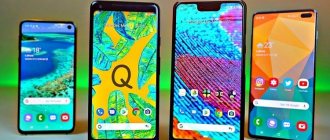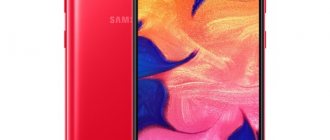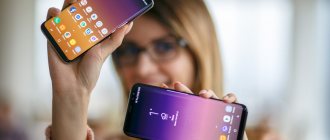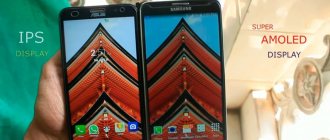AMOLED screens are considered the best for a reason. Their operating principle is based on organic light-emitting diodes, that is, each pixel glows independently. Thanks to this, it was possible to achieve a number of advantages - improve color reproduction and make it more natural, reduce energy consumption, introduce Always On Display technology and under-screen fingerprint sensors. In addition, work is actively underway to create a camera that can be hidden in the screen, and this will eliminate cutouts, holes, frames and periscope cameras. IPS displays cannot offer all this, although they have their advantages. If you decide to buy a smartphone with an Amoled display, then below is a selection of the best models in 2020.
Xiaomi Mi A3
- Screen: AMOLED, 6.09 inches, 1560*720
- Battery: 4030 mAh
- Camera (front/main): 32 MP/48+8+2 MP
- OS: Android 9 One
Price: from 12,600 rub.
Buying a smartphone with an Amoled display for up to 15,000 rubles is difficult - the technology is still expensive. However, Mi A3 is a device that can be called an exception to the rule. This is an affordable phone with a cool camera, clean Android, good performance based on Snapdragon 665 and a high-quality screen, the only drawback of which is a modest resolution - only HD+. The model is available in 4/64 and 4/128 GB versions. Unlike its predecessor, it has a headphone jack, NFC and support for memory cards. The battery supports fast charging.
Advantages:
- Affordable price
- Good photo opportunities
- Pure Android.
- Performance is enough for everyday tasks.
- There is NFC.
Flaws:
- Lots of built-in advertising.
- You cannot use two SIM and microSD at the same time.
Middle price segment
Mid-priced smartphones with an AMOLED display boast a number of innovative features: Quick Charge, NFC, fingerprint scanner and facial recognition - all these features will make the user's daily life easier.
Meizu 16Xs is the best camera in the mid-price segment
The new product from Meizu inherited the flagship features of the 16S model, while maintaining a stylish design and a number of advanced camera functions. In terms of technical characteristics, Meizu 16Xs is a strong mid-ranger, capable of competing with industry giants like Samsung and Huawei. The 6.2-inch AMOLED screen almost completely covers the front panel and looks harmonious without any cutouts on top.
The slim body houses a capacious 4000 mAh battery. When playing video in 2K resolution, the phone can work for about 17 hours on a single charge. The cameras have three modules for different shooting: wide-angle, standard and portrait with blur effect. In terms of performance, Meizu 16Xs will handle all modern games, as it is equipped with a Qualcomm Snapdragon 675 processor and 6 GB of RAM.
Advantages:
- intuitive interface;
- application speed;
- ideal price-quality ratio;
- frameless screen;
- compactness.
Flaws:
- raw software;
- The camera is very noisy in low light.
Vivo V17 – AI quad camera with 48 MP module
Vivo late last year released its main line smartphone with a unique design and new generation cameras with artificial intelligence. Vivo V17 also has a large 6.38-inch AMOLED screen with a resolution of 2340×1080 and natural color reproduction. This display is comfortable for watching videos and playing games.
Autonomy is provided by a 4500 mAh battery, guaranteeing more than 15 hours of video viewing at maximum brightness. The main hardware is not inferior to the battery - 8 GB of RAM is enough to run many applications in multitasking mode. For gaming, Vivo V17 is powered by the current generation Qualcomm Snapdragon 665 processor.
Advantages:
- camera with natural color rendering;
- Beautiful design;
- optimized shell;
- silicone bumper included;
- Quick Charge.
Flaws:
- low quality sound from external speaker;
- There are no battery consumption statistics.
Black Shark 2 – gaming smartphone with 12 GB of RAM
Xiaomi's gaming phone was developed by the Black Shark division and is built on the new 8-core Snapdragon 855+ processor, which provides a 15% performance increase compared to the previous generation. In addition to it, 12 GB of RAM is installed. The updated cooling system removes heat from important elements of the smartphone.
The 6.39-inch display with a resolution of 2340x1080 pixels is designed specifically for games, as it transmits images at 240 Hz. For photography, there is a dual 48+12 MP camera with the ability to record video in 4K 60fps. The 4000 mAh battery supports fast charging. Black Shark 2 is available in black and silver.
Advantages:
- high-quality sound with bass;
- silicone case included;
- detailed sensor and screen settings;
- Quick Charge;
- high performance in games.
Flaws:
- NFC not working in Russia.
Samsung Galaxy M21
- Screen: AMOLED, 6.4 inches, 2340*1080
- Battery: 6000 mAh
- Camera (front/main): 20 MP/48+8+2 MP
- OS: Android 10
Price: from 13,900 rub.
The first smartphones with an AMOLED display were produced by Samsung. These were extremely expensive devices, but over time the brand allowed itself to install such a matrix in more affordable models. M21 is a new product that, in addition to a large AMOLED screen, offers a capacious battery with support for fast charging. The phone has everything you need for an inexpensive model - a good camera, adequate performance on the proprietary Exynos 9611 chipset, NFC and the ability to use microSD and two SIM cards at the same time. The M21 memory is represented by a combination of 4/64 GB, which is modest for modern realities, but forgivable given the cost and other characteristics.
Advantages:
- Works for a long time without charging.
- No need to choose between SIM and microSD.
- Takes good photographs.
- Fast charging.
Flaws:
- Permanent memory is not enough by modern standards.
- Thick frames around the display.
What is an AMOLED display, its advantages and disadvantages
If LCD displays use so-called liquid crystals, then the AMOLED screen works on a completely different principle - organic light-emitting diodes. They are controlled by an active matrix made of thin-film transistors. The new displays have a number of important advantages:
- improved color rendering
- high contrast
- thinner screen
- reduced energy consumption
Therefore, the answer to the question of what is better for the eyes - AMOLED or IPS - is clear - new technologies significantly reduce fatigue due to high image quality.
Unfortunately, producing AMOLED displays is significantly more expensive than liquid crystal displays. Therefore, it is simply impossible to produce smartphones with large screens at a low price. And in general, budget smartphone models often have unbalanced color reproduction.
Meizu 16Xs
- Screen: AMOLED, 6.2 inches, 2232*1080
- Battery: 4035 mAh
- Camera (front/main): 16 MP/48+5+8 MP
- OS: Android 9.0
Price: from 16,700 rub.
Smartphones with Amoled screens are not very widely represented in the mid-price segment. Often those who do not want to buy Samsung simply do not have much choice. Meizu 16Xs is not an ideal model, but it has its advantages. Firstly, the screen here is without any cutouts or holes - there is a frame, but it is modest. Secondly, the device can boast of shooting – the main camera takes pictures well in any lighting. The device is powered by Snapdragon 675, with a choice of memory – 6/64 GB or 6/128 GB. The main drawback is that there is no NFC and you cannot install microSD.
Advantages:
- Great display with no notches.
- The main module takes high-quality pictures.
- Performance is sufficient for most tasks.
- The battery lasts a long time.
Flaws:
- Memory cards are not supported.
- No NFC.
Realme 7 Pro
Price: from 22,973 rubles
The most advanced phone with an Amoled screen among relatively inexpensive devices is Realme 7 Pro. Of course, the price tag of 25 thousand in official retail cannot be called cheap, but from time to time you can catch it at promotions, and for 20 kes you can get a smart phone with decent hardware and cool flagship features.
Inside there is an excellent Snapdragon 720 chip, 8/128 GB of fast memory, a decent 64+8+2+2 MP quad camera with wide width, NFC, powerful stereo speakers, and a 4500 mAh battery. The most important feature of this phone is the 65W reactive charging that can charge it from 0 to 100% in 34 minutes. This is an outstanding indicator that is not available in most modern flagships. The only downsides are the plastic body and poor sound quality when recording video: Vivo did something crazy with noise reduction, which is why the sound in video is barely audible, but this problem should be solved with updates.
What do you think of these phones? Write in the comments which affordable smart phone with an AMOLED screen would you choose for yourself, and what interesting models we forgot to mention.
Vivo V17 Neo
- Screen: AMOLED, 6.38 inches, 2340*1080
- Battery: 4500 mAh
- Camera (front/main): 32 MP/16+8+2 MP
- OS: Android 9.0
Price: from 16,500 rub.
V17 Neo is another representative of the mid-segment. It will delight you with an excellent screen, good photography (users especially praise the front camera), a large memory reserve - 6/128 GB and a capacious battery that provides a day of active use. The phone has a separate slot for MicroSD and NFC. Among the shortcomings is the Helio P65 processor. It provides sufficient performance for everyday use, but the solution is not the most interesting for its price.
Advantages:
- Great selfie camera.
- Big battery.
- Dedicated slot for microSD.
- Lots of memory.
Flaws:
- Old microUSB connector.
- The processor is weak.
OPPO Reno Z
- Screen: AMOLED, 6.4 inches, 2340*1080
- Battery: 4035 mAh
- Camera (front/main): 32 MP/48+5 MP
- OS: Android 9.0
Price: from 20,000 rub.
Reno Z is a smartphone with a high-quality large screen, excellent photo shooting and a pleasant appearance. Unlike the models listed above, its body is glass, which is more pleasant both tactilely and visually. The model runs on Helio P90 and has 4/128 GB of memory. There is also NFC and the headphone jack is still there.
Advantages:
- Glass body.
- Great photography.
- Lots of memory.
- Support for contactless payments.
Flaws:
- MicroSD is not supported.
The best inexpensive smartphones with an AMOLED display
For the vast majority of buyers, cost is one of the main selection criteria. Smart users don't want to pay extra money for a smartphone whose features won't be used to their fullest. For such buyers, we can recommend an inexpensive smartphone that can make calls regularly and perform the required minimum functions. Most often, it is due to their simplicity that such models are highly reliable. In addition, they depreciate much more slowly. Therefore, having decided to buy a budget Chinese smartphone, users subsequently do not regret wasting money.
Samsung Galaxy A22 4/64GB
The South Korean giant is actively updating one of its most popular Galaxy A lines. The most affordable smartphone in the series, equipped with an AMOLED matrix, is the A22. The design of the device is neat, visually creating the feeling that its back is made of glass. But tactilely it’s immediately clear that this is glossy plastic, which will have to be protected from dirt, fingerprints and numerous scratches with a cover. Unfortunately, it is not included in the kit.
If you prefer transparent cases or risk carrying your smartphone without them, then you can pay attention to the color of the case. Available in black, white and mint.
The performance of the Galaxy A22 is even slightly superior to the older model A32. This is due to the screen resolution reduced to HD+. Nevertheless, the eyes will not cling to the pixels, and the picture quality is good. The increased scan rate of 90 Hz has not gone away either. The drive of a budget smartphone model with an AMOLED matrix can be 64 or 128 GB in size. It will be possible to expand it with microSD, but only by abandoning the second SIM card.
Advantages:
- good performance;
- scanner in the power button;
- battery with a capacity of 5000 mAh;
- screen refresh rate;
- fast shell operation;
- pleasant tactile sensations;
- support for payment via NFC.
Flaws:
- The resolution will not suit everyone.
OPPO A74 4/128GB
One of the main competitors for smartphones from the Korean manufacturer. The A74 model has a Snapdragon 662 processor. It is almost identical in both computing power and graphics subsystem to the Helio G80 + Mali-G52 combination from the Galaxy A22. But Qualcomm’s energy efficiency is better, so an OPPO smartphone lasts a little longer on a battery of the same capacity. RAM is the same 4 GB, storage is 128 GB.
The front camera is not bad, but does not show anything special. It is embedded in the upper left corner of the screen, which looks neater than a drop. In-screen fingerprint scanner. The diagonal of the latter is 6.43 inches, which in a resolution of 2400x1080 pixels provides a density of 409 ppi. There is no increased Hertz. The main camera consists of three modules, the really useful one of which is the main one at 48 megapixels. But at night he doesn’t take it out either.
Advantages:
- nice appearance;
- excellent performance;
- holds the battery charge well;
- good speaker;
- copes well with games;
- 128 GB storage;
- camera capabilities during the day.
Flaws:
- minor flaws in the software.
Samsung Galaxy A32 64GB
The hardware platform of the Galaxy A32 smartphone is completely similar to the younger model. Even the amount of RAM and permanent memory, battery size and set of wireless modules are identical to the A22. Nevertheless, it makes sense to overpay several thousand for this gadget. Firstly, the rear camera of an inexpensive smartphone with a good screen takes much better pictures. The main module here is represented by a 64 megapixel sensor, which takes excellent photos during the day. In the evening, unfortunately, none of the sensors cope with noise. Secondly, the screen is better here. It is brighter (maximum almost 450 cd/m2), the resolution of the matrix is 2400 × 1080 pixels. Many will also be pleased with the fingerprint scanner under the display, and not in the power button. It works accurately, but in some cases it is not fast enough.
Advantages:
- fast charging support;
- good display brightness;
- excellent main camera;
- built-in screen scanner;
- excellent autonomy;
- One UI shell optimization.
Flaws:
- the scanner is sometimes slow;
- performance is lower than A22.
ZTE Axon 10 Pro
- Screen: AMOLED, 6.47 inches, 2340*1080
- Battery: 4000 mAh
- Camera (front/main): 20 MP/48+20+8 MP
- OS: Android 9.0
Price: from 33,500 rub.
Axon 10 pro is a smartphone with a high-quality AMOLED display, beautiful appearance, an excellent camera and a powerful Snapdragon 855 chipset. In addition, the model received NFC, fast and wireless charging, an under-screen fingerprint sensor and stereo speakers. Considering that this is a flagship and quite expensive device, the memory looks modest - 6/128 GB.
Advantages:
- Beautiful appearance.
- Good ergonomics.
- Excellent photo opportunities.
- Great sound.
- Powerful processor.
Flaws:
- Hybrid slot.
- Low memory.
- No 3.5.
List
Samsung Galaxy:
- S4 mini, S5 mini
- S6
- S7, S7 Edge
- S8, S8+
- S9, S9+
- Note5, Note8, Note9
- J1 (2016), J2 (2018), j3 (2016), J4 (2018), J5 (2016, 2017), J6 (2018), J7 (2017), J7 Pro, J8 (2018)
- C5, C7, C8, C9 Pro
- A3 (2017), A5, A6, A6+, A7 (2016, 2017), A8, A8+, A9 Pro
Huawei:
- Honor Note 8, Magic
- P20 Pro
- Mate 9
- Pixel
- Pixel XL
- Pixel 2
Meizu
- 15, 15 Plus
- Pro 6s, Pro 7, Pro 7 Plus
- MX5
Other:
- OnePlus X, 3T, 5, 5T, 6
- Xiaomi Mi8, Mi 8 SE, Mi 8 Explorer Edition
- Motola Moto Z, Z2
- Vivo Nex, Nex S, X20 Plus, X9, X21
- ZTE Nubia M2, Axon 7 Mini, Z11, Blade A910
- Asus ZenFone 4, 3
- Doogee Mix
- OUKITEL K8000
- Highscreen Fest Pro, Razar, Razar Pro
- Prestigio Grace
- HTC One A9
- OPPO R11
This list is current as of the end of 2022, it is constantly updated and it is almost impossible to track the appearance of smartphones from all brands with AMOLED matrices.
Samsung Galaxy S10e
- Screen: AMOLED, 5.8 inches, 2280*1080
- Battery: 3100 mAh
- Camera (front/main): 10 MP/16+12 MP
- OS: Android 9.0
Price: from 36,800 rub.
The S10e is the junior device in Samsung's 2019 flagship line. The device was included in the rating due to the fact that it is one of the few compact smartphones on the market, and besides, it is able to offer excellent parameters for relatively little money. It has everything that should be in a top-end smartphone of our time - a high-quality screen, excellent performance (Exynos 9820, 6/128 GB), good photo capabilities, autonomy, as well as such nice things as fast and wireless charging, NFC, IP68 moisture protection, stereo speakers . In addition, the S10e did not deprive the headphone output and support for a memory card, but the connector is a hybrid one.
Advantages:
- Good quality photos and videos.
- High performance.
- Fast and wireless charging.
- Moisture protection.
- Compact body.
- Great display.
Flaws:
- Low memory.
- Combined connector.
OnePlus 7T Pro
- Screen: Fluid AMOLED, 6.67 inches, 3100*1440
- Battery: 4085 mAh
- Camera (front/main): 16 MP/48+8+16 MP
- OS: Android 10
Price: from 50,500 rub.
Manufacturers love to come up with their own marketing names for technologies that are familiar to everyone. So some brands call their screens Super AMOLED, and OnePlus came up with the Fluid prefix, which in this case means curved. 7T Pro is the flagship of 2022, which at the time of its release won the title of the device with the best display, and at the end of the year, many even consider it the best phone in 2022. The screen received a high QHD+ resolution, HDR+ support and a refresh rate of 90 Hz. Taken together, all this provided a really, really cool picture. And besides this, the model is distinguished by top-end performance - Snapdragon 855 Plus and 8/256 GB, stereo speakers, a good camera, and a fast fingerprint sensor on the screen.
Advantages:
- Premium appearance.
- Very powerful.
- High-quality photos and videos.
- One of the best screens on the market.
- Stereo speakers.
Flaws:
- Memory cards are not supported.
- No wireless charging.
- No 3.5.
- No moisture protection.
Premium class
Initially, AMOLED screens were installed in Samsung's flagship models, after which other manufacturers also began to use this technology. Today, premium smartphones are equipped with superAMOLED matrices, which are 20% brighter than their predecessors and more effectively reduce power consumption.
Samsung Galaxy S10+ is the winner of the “Phone of the Year” 2019 competition
The Korean flagship did not become a revolution in the world of mobile devices, but it contained all the key functions and features of Samsung smartphones. The appearance is distinguished by its rectangular shapes: the body and the cutout for the camera module look stylish and futuristic.
The Galaxy S10+ has received the latest Pro-grade update for the main camera, making it easier to manage photo and video shooting modes. Lots of custom filters to help make your photos more attractive. Quick Share mode allows you to quickly transfer footage between multiple devices at the same time. The Samsung Galaxy S10+ has virtually no flaws, and in terms of performance and battery life it beats most of its price competitors.
Advantages:
- great design;
- excellent price-quality ratio;
- face recognition in low light;
- soft vibrations;
- Built-in memory capacity 128 GB.
Flaws:
- sits down quickly during active work;
- brake fingerprint scanner.
HUAWEI P20 Pro – Leica triple camera
The Chinese company Huawei has released two flagship smartphones: P20 and P20 Pro. The older model is positioned as a new generation device, featuring a unique Leica triple camera and high performance. The phone looks and feels like real steel and feels pleasantly cool on the hand. Both panels are glass, reflecting the sun's rays.
The front camera has a 24 megapixel sensor for creating stunning portraits. The triple main camera, thanks to the f/1.6 lens, receives a lot of light and is responsible for detailed photos and the absence of noise. In good lighting, you get clear, life-like images. The hardware platform is built on the company's most powerful processor - HiSilicon Kirin 970. HUAWEI P20 Pro easily copes with heavy tasks and outperforms competitors due to its unique camera.
Advantages:
- image saturation;
- video stabilization;
- slow motion mode;
- a fingerprint scanner plays the role of navigation buttons;
- Lots of personalization options.
Flaws:
- the main camera requires fine tuning;
- narrow earpiece speaker.
OnePlus 7 Pro – less than 0.5 seconds to unlock
OnePlus 7 Pro is the leader in performance in the flagship segment. The smartphone is equipped with the most powerful 8-core Snapdragon 855 chipset with 6 GB of RAM. This filling eliminates lags and freezes when launching heavy applications and 3D games of the latest generation. Due to the 7-nm process technology, battery power is saved during multitasking mode.
Professional quality photos are provided by a 48+16+8 megapixel triple camera with an f/1.6 aperture and dual optical stabilization. A wide-angle lens with a viewing angle of 117° allows you to create an impressive panorama. Thanks to a capacious 4000 mAh battery, OnePlus 7 Pro lasts throughout the day with active use.
Advantages:
- 90 Hz screen;
- resolution 2K;
- fine tuning of an expanded color gamut;
- HDR+;
- best processor 2022.
Flaws:
- huge size 6.67 inches;
- The battery lasts a maximum of a day in active mode.
Xiaomi Mi Note 10 – AMOLED display with curved edges
The flagship smartphone Xiaomi Mi Note 10 impresses at first glance. The body is made of glass and metal in green, smoky or coral colors. The front panel is protected by Corning Gorilla Glass 5, which resists minor impacts and scratches. Oleophobic coating repels oils from the bright and rich 6.47-inch AMOLED display. The 5260 mAh battery is quickly charged using Quick Charge technology with a 30-watt power supply.
A module of five cameras is provided for any occasion - portraits, landscapes and panoramas are rich and detailed. The 2 MP macro lens has a powerful zoom for capturing distant objects. Xiaomi Mi Note 10 is an advanced smartphone on the edge of technical capabilities.
Advantages:
- two days of active work without recharging;
- rounded edges inside the screen;
- fits comfortably in the hand;
- case included;
- optical stabilization.
Flaws:
- MIUI shell rarely receives updates;
- there is no moisture protection.
OnePlus 8 Pro
- Screen: Fluid AMOLED, 6.78 inches, 3168*1440
- Battery: 4510 mAh
- Camera (front/main): 16 MP/48+8+48+5 MP
- OS: Android 10
Price: from 67,700 rub.
The new 2022 OnePlus 8 Pro received an even better 10-bit display with a frequency of 120 Hz, which again breaks records and has every chance of becoming the best again. In addition, there is a Snapdragon 865 and 8/128 or 12/256 GB of memory. The model received moisture protection, wireless, fast and reverse charging, stereo speakers, an under-screen finger scanner and face unlock.
Advantages:
- Very cool display.
- Top performance.
- 5G support.
- Moisture protection IP68.
- High quality sound.
Flaws:
- Considering the price tag, the camera takes poor pictures - perhaps the situation will improve with updates.
- Wireless and fast charging are supported only by branded accessories.
- Minimal design changes compared to previous generations.
- Very high price.
- Heats up quickly.











